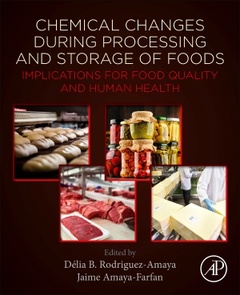Chemical Changes During Processing and Storage of Foods Implications for Food Quality and Human Health
Coordonnateurs : Rodriguez-Amaya Delia B., Amaya-Farfan Jaime

Chemical Changes During Processing and Storage of Foods: Implications for Food Quality and Human Health presents a comprehensive and updated discussion of the major chemical changes occurring in foods during processing and storage, the mechanisms and influencing factors involved, and their effects on food quality, shelf-life, food safety, and health. Food components undergo chemical reactions and interactions that produce both positive and negative consequences. This book brings together classical and recent knowledge to deliver a deeper understanding of this topic so that desirable alterations can be enhanced and undesirable changes avoided or reduced.
Chemical Changes During Processing and Storage of Foods provides researchers in the fields of food science, nutrition, public health, medical sciences, food security, biochemistry, pharmacy, chemistry, chemical engineering, and agronomy with a strong knowledge to support their endeavors to improve the food we consume. It will also benefit undergraduate and graduate students working on a variety of disciplines in food chemistry
1. Introduction (Societal Role of Food Processing: Envisaging the Future) 2. Denaturation of Proteins, Generation of Bioactive Peptides, Alterations of Amino Acids 3. Oxidation of Proteins 4. Oxidation of Lipids 5. Alterations of Polysaccharides, Starch Gelatinization and Retrogradation 6. The Maillard Reaction and Caramelization 7. Alterations of Natural Pigments 8. Degradation of Vitamins 9. Generation of Process-derived Flavors 10. Formation of Processing-induced Toxicants 11. Generation and Alteration of Other Bioactive Compounds 12. Reactions and Interactions of Food Additives 13. Measuring Chemical Deterioration of Foods
Jaime Amaya-Farfan is a professor in the Food and Nutrition Department of the University of Campinas, São Paulo, Brazil. He has taught the chemistry, properties, and transformation of food proteins as well as the biochemistry of micronutrients and bioactive substances for the last 25 years. His most recent contributions to the field are on the health effects of processing and the overall interaction between food components, particularly the proteins, with living organisms. His research interests focus on the relationship between dietary proteins, dietary stressors, and the gut microbiota with long-term food safety. He has written over 140 research and review papers and book chapters in international books. He is a fellow of the International Academy of Food Science and Technology.
- Offers a comprehensive overview of the major chemical changes that occur in foods at the molecular level and discusses the positive and negative effects on food quality and human health
- Describes the mechanisms of these chemical changes and the factors that impede or accelerate their occurrence
- Helps to solve daily industry problems such as loss of color and nutritional quality, alteration of texture, flavor deterioration or development of off-flavor, loss of nutrients and bioactive compounds or lowering of their bioefficacy, and possible formation of toxic compounds
Date de parution : 11-2020
Ouvrage de 722 p.
19x23.3 cm
Thème de Chemical Changes During Processing and Storage of Foods :
Mots-clés :
?2-diol; Acrylamide; Additives; Amadori rearrangement; Anthocyanins; Antioxidant; Benzene; Betacyanins; Bioactive compounds; Biogenic amines; Carotenoids; Catechins; Cheese flavor; Chemical deterioration; Chemical reactions; Chlorophylls; Chocolate flavor; Chromatographic method; Coffee flavor; Colorant; Consumer’s benefits; Corporate responsibility; Coumarins; Degradation; Degradative reactions; Discoloration; Electronic eye; Electronic nose; Electronic tongue; Ethyl carbamate; Factors affecting vitamin losses; Fat-soluble vitamins; Flavonoids; Flavor compounds; Flavoring; Food; Food processing effects; Food quality; Food safety; Food security; Food sources; Fruit flavor; Functionality; Functions; Furan; Health consequences of food processing; Health effects; Health implications; Health significance of food bioactive peptides; Heterocyclic amines; Heyns rearrangement; Human health; Hydroperoxides; Individual responsibility; Influencing factors; Interactions; Isoflavones; Lipid oxidation; Lipid-derived off-flavor; Lipid-derived toxic substances; Loss of color; Maillard reactions; Meat flavor; Melanoidins; Milk flavor; Modification; Modified food proteins; Monochloropropane-1; Multidisciplinary solutions; Natural pigments; Nitrites; Nitrosamines; Nonenzymatic browning; Nutritional security; Organosulfur compounds; Oxidation; Physicochemical analysis; Polysaccharides; Processing; Protein; Protein degradation and health; Protein glycation; Quality; Rancidity; Reactions; Sensory evaluation; Society and processed foods; Spectroscopic method; Stabilizing techniques; Starch; Stilbenes; Storage; Strecker degradation; Structure; Sulfites; Sustainability; Vegetable flavor; Water-soluble vitamins; Wine flavor



